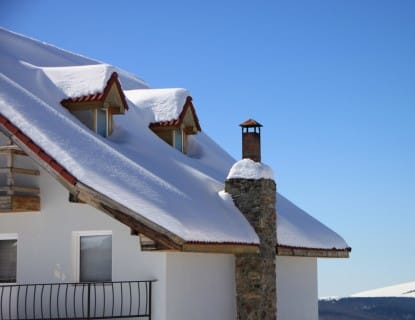When is it Time to Shovel the Snow from the Roof?
Feb 17, 2015
The state of New Hampshire provides this information in order for property owners to make an informed decision as to when they should consider removing snow from a roof.
Did you know that the weight of snow varies? Light fluffy snow may only weigh about seven pounds per cubic foot while more average snow may weigh 15 to 20 pounds per cubic foot depending on how compact and saturated it is.
Snow drifts, due to the fact they are compacted, would probably be at the higher amount closer to 20 pounds per cubic foot.
Roofs are designed to carry the normal snow load for a specific location as specified in the State Building Code. However, the design load is having the snow spread out equally across the roof.
The recent snowfall in combination with the wind has caused snow on one side to be clear and the other to have a large drift which causes an imbalanced load on the roof making it more susceptible to collapse. Also bear in mind taking all the snow off one side but none off the other will have the same effect.
A simple way to determine the weight of the snow at your location is to use a piece of PVC pipe with a cap to push down to the base of the snow for a sample of the snow. Then upright it and let it melt. When the snow melts if you have 8 inches of water in the PVC pipe it equals 41 pounds per square foot and would go up or down with each inch of water by 5.2 pounds. This is a rough estimate figure and should be used with caution.
If you are not sure of the capacity of your roof, consult with a structural engineer to review the design of your roof structure. If you think your roof may have been compromised, consult with a reputable builder and your local building official.
Roofs that are flat also have a maximum snow load they can carry. With flat roofs it is important to keep the roof drains clear of snow, leaves and ice.
Remember the rule of thumb that condensed saturated snow weighs about 20 pounds per cubic foot and keep in mind the design capacity of your roof structure. There are potential dangers of shoveling or raking snow from a roof, besides the collapse danger. There are the dangers of a person sliding off the roof, falling from a ladder, overexertion, or falling snow sliding on top of them.
The decision of an individual property owner should consider the dangers against the benefits of removing the snow in determining their course of action. For more information contact: State Fire Marshal J. William Degnan (603-223-4289)
To help prevent injury, shovel periodically when heavy accumulation is expected.
Shoveling 1 inch of snow four times is much easier and faster than trying to shovel 4 inch deep snow all at once. The optimal throwing distance is about 3 feet. Using the recommended rate for continuous shoveling (15 scoops per minute), the recommended load lifted should not exceed 10 to 15 lb. The recommended rate for continuous shoveling tasks is usually considered to be around 15 scoops per minute.
As you shovel, it is important to remember to lift with your legs, not your back or arms. Be sure to bend your knees and lift the shovel in one fluid motion. Courtesy of Advanced Pain Management, Greenfield, WI
Shoveling your roof? Clear snow from around the foundation and out of and away from, below grade window wells. When this snow begins to melt, you want to do everything you can to ensure that the basement remains dry.
If you are already seeing signs of water or elevated dampness in the basement, call us. Our schedule fills up quickly as the thaw begins.
Call 800.445.7593 or click here to request a basement evaluation
